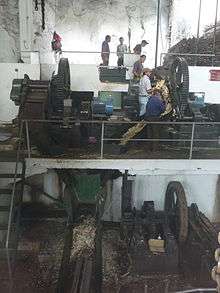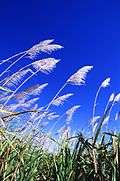Bagasse

Bagasse (/bəˈɡæs/ bə-GAS) is the fibrous matter that remains after sugarcane or sorghum stalks are crushed to extract their juice. It is dry pulpy residue left after the extraction of juice from sugar cane.[1] Bagasse is utilized as a biofuel and in the manufacture of pulp and building materials.
"Agave bagasse" is a similar material that consists of the tissue of the blue agave after extraction of the sap.
Production, storage and composition
For each 10 tonnes of sugarcane crushed, a sugar factory produces nearly 3 tonnes of wet bagasse. Since bagasse is a by-product of the cane sugar industry, the quantity of production in each country is in line with the quantity of sugarcane produced.
The high moisture content of bagasse, typically 40 to 50%, is detrimental to its use as a fuel. In general, bagasse is stored prior to further processing. For electricity production, it is stored under moist conditions, and the mild exothermic reaction that results from the degradation of residual sugars dries the bagasse pile slightly. For paper and pulp production, it is normally stored wet in order to assist in removal of the short pith fibres, which impede the papermaking process, as well as to remove any remaining sugar.
A typical chemical analysis of bagasse might be (on a washed and dried basis):[2]
- Cellulose 45–55%
- Hemicellulose 20–25%
- Lignin 18–24%
- Ash 1–4%
- Waxes <1%
Bagasse is an extremely inhomogeneous material comprising around 30-40% of "pith" fibre, which is derived from the core of the plant and is mainly parenchyma material, and "bast", "rind", or "stem" fibre, which comprises the balance and is largely derived from sclerenchyma material. These properties make bagasse particularly problematic for paper manufacture and have been the subject of a large body of literature.
Use

Many research efforts have explored using bagasse as a renewable power generation source and for the production of bio-based materials.
Fuel
Bagasse is often used as a primary fuel source for sugar mills; when burned in quantity, it produces sufficient heat energy to supply all the needs of a typical sugar mill, with energy to spare. To this end, a secondary use for this waste product is in cogeneration, the use of a fuel source to provide both heat energy, used in the mill, and electricity, which is typically sold on to the consumer electricity grid.
The resulting CO2 emissions are less than the amount of CO2 that the sugarcane plant absorbed from the atmosphere during its growing phase, which makes the process of cogeneration greenhouse gas-neutral. In many countries (such as Australia), sugar factories significantly contribute 'green' power to the electricity supply. For example, Florida Crystals Corporation, one of America's largest sugar companies, owns and operates the largest biomass power plant in North America. The 140 MW facility uses bagasse and urban wood waste as fuel to generate enough energy to power its large milling and refining operations as well as supply enough renewable electricity for nearly 60,000 homes. Hawaiian Electric Industries also burns bagasse for cogeneration.
Ethanol produced from the sugar in sugarcane is a popular fuel in Brazil. The cellulose-rich bagasse is being widely investigated for its potential for producing commercial quantities of cellulosic ethanol. For example, until May 2015 BP was operating a cellulosic ethanol demonstration plant based on cellulosic materials in Jennings, Louisiana.
Pulp, paper, board and feed
Bagasse is commonly used as a substitute for wood in many tropical and subtropical countries for the production of pulp, paper and board, such as India, China, Colombia, Iran, Thailand and Argentina. It produces pulp with physical properties that are well suited for generic printing and writing papers as well as tissue products but it is also widely used for boxes and newspaper production.[3] It can also be used for making boards resembling plywood or particle board, called Bagasse board and Xanita board, and is considered a good substitute for plywood. It has wide usage for making partitions, furniture etc.
The industrial process to convert bagasse into paper was developed in 1937 in a small laboratory in Hacienda Paramonga, a sugar mill in the coast of Peru owned by W.R. Grace Company. With a promissing method, the company bought an old paper mill in Whippany, New Jersey and shipped bagasse from Peru to ensure the viability of the process in an industrial scale. The first paper manufacturing machine were designed in Germany and installed in the Cartavio sugar cane plant in 1938.[4] Sociedad Paramonga was bought in 1997 by Quimpac[5] and in 2015 produced 90,000 metric tons of office paper, toilet paper and cardboard for the Peruvian market.[6]
K-Much Industry has patented a method of converting bagasse into cattle feed by mixing it with molasses and enzymes (such as bromelain) and fermenting it. It is marketed in Thailand, Japan, Malaysia, Korea, Taiwan and Middle East and Australia as "fiber rich".
Xanita, a South African company, mixes 30% bagasse cellulose fibres in with recycled kraft paper fibre to make ultra lightweight composite boards. These are sold as an environmentally-friendly, formaldehyde-free alternative to MDF and particleboard.[7]
Health impact
Workplace exposure to dusts from the processing of bagasse can cause the chronic lung condition pulmonary fibrosis, more specifically referred to as bagassosis.[8]
Human consumption
Processed bagasse is added to human food as sugar cane fiber.[9] It is a soluble fiber but can help promote intestinal regularity.[10] One animal study suggests that sugar cane fiber combined with a high fat diet may help control Type 2 diabetes.[11]
See also
| Wikimedia Commons has media related to Bagasse. |
References
- ↑ Bagasse – Britannica Online Encyclopedia
- ↑ Rainey, Thomas J (2009). A study of the permeability and compressibility properties of bagasse pulp. Brisbane, Australia: Queensland University of Technology.
- ↑ Rainey, Thomas J (2009). A study of the permeability and compressibility properties of bagasse pulp. Brisbane, Australia: Queensland University of Technology.
- ↑ Lawrence A., Clayton (1985). Grace: W.R. Grace & Co., the Formative Years, 1850-1930. Ottawa, IL: Jameson Books. p. 354. ISBN 0915463253.
- ↑ "Quimpac corporate website". Quimpac – Nuestra empresa: Quienes Somos. Quimpac. Retrieved April 9, 2016.
- ↑ "Quimpac paper division". Quimpac – Negocios Papel. Quimpac. Retrieved April 9, 2016.
- ↑ Xanita | Lightweight Fibreboards
- ↑ Sodeman, William A (October 1967). "Bagasse Disease of the Lungs – After 25 Years" (PDF). Chest. 52 (4): 505–507. doi:10.1378/chest.52.4.505. PMID 6058449.
- ↑ http://www.nutrition411.com/content/fiber-facts-understanding-food-labels-and-isolated-fibers
- ↑ http://www.nutrition411.com/content/fiber-facts-understanding-food-labels-and-isolated-fibers
- ↑ Wang ZQ, Zuberi AR, Zhang XH, Macgowan J, Qin J, Ye X, Son L, Wu Q, Lian K, Cefalu WT (2007). "Effects of dietary fibers on weight gain, carbohydrate metabolism, and gastric ghrelin gene expression in mice fed a high-fat diet". Metab. Clin. Exp. 56: 1635–42. doi:10.1016/j.metabol.2007.07.004. PMC 2730183
 . PMID 17998014.
. PMID 17998014.
Further reading
- The Potential of Bagasse-Based Cogeneration in the US, Kevin Ho, Columbia University, 2006.

